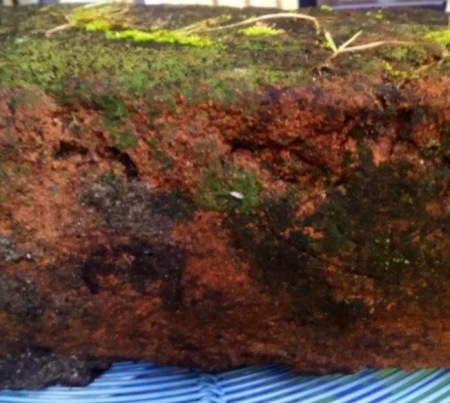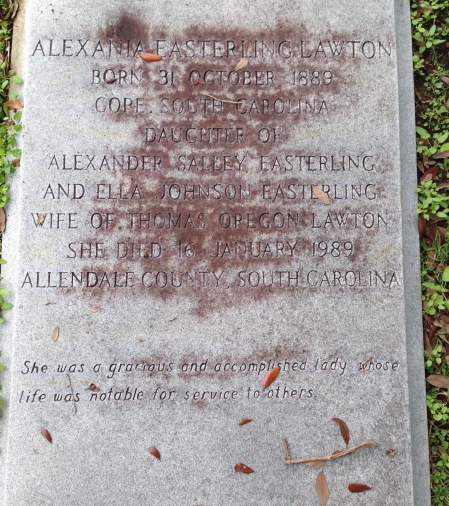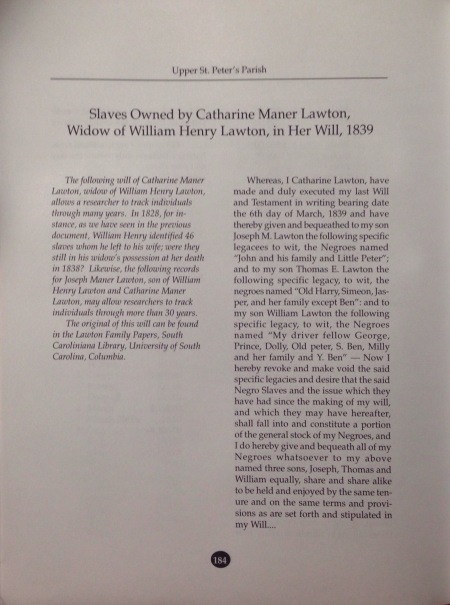From Tommy Lawton’s book…
Archive for January, 2016
Slaves Owned by William Henry Lawton at His Death, 1827
January 26, 2016Stopping at Davant to Look at Bricks
January 24, 2016Sugar has an idea to take some photos of the brick work at the entrance gate of Davant Plantation. We head over that way and approach from a side road where we see a construction sign and what looks to be a golf course being built. Later we check the Internet and we see that it’s true. (Not a fan of golf courses, so we’ll be checking in from time to time to watch the progress.)
Anyway, now we’re at the entrance gate of Davant.

The main pillars are perhaps 7 feet high. The open-work walls are not quite as tall and are double-thick.




The brick walls themselves are built in a gentle, undulating line.
The Baptist Church at Gillisonville
January 21, 2016We headed the long way around to get home. That’s generally the path you take in these parts – the long way – because there are enormous tracts of land that impede your progress along the roadways. There are hunting plantations (hunt clubs, if you will), agricultural establishments, swamps, rivers, marshes, and private lands.
Sugar and I are headed over to Gillisonville to take a photo of the entrance of Davant Plantation. His cousin Elisabeth had an ancestor who was Evalina Loyer Davant and most probably grew up here, since her father owned it before she was born and during her life until she married Edward Payson Lawton.
But first we swing into the lot at Gillisonville Baptist. It survived the war when many places did not.
I met a woman a few weeks ago who moved to a little town in Colleton County. She said she couldn’t figure out why people here were still fighting the war, and that they needed to “get over it”. I told her that I grew up in East Tennessee and the war was not in my conscious thought until I moved to an area where Sherman went through. Firsthand accounts tell if the destruction and fear that swept through with the approach of the troops. The winds carried the smell of sulphur and smoke, the rotting flesh of the animal carcasses, the cries of the people. It was wintertime, almost exactly 151 years ago. I’m cold, but I have access to reliable heat. I’m hungry, but I have access to food at a moment’s notice. I’m alone, but I have Sugar and my children and the animals and the Internet.
Get over it? Actually, I get it now.
Let me carve that in your church’s silver and see how you feel now.
Because I’m Obsessed With Old Bricks
January 21, 2016I found an old brick lying on the ground at Black Swamp Plantation. There are ruins of steps there, the remainder of an entry staircase from when the house was burned by Sherman in 1865.
I didn’t dislodge it. I didn’t pry it from the staircase, although one of those tread bricks with the rounded front would have been amazing to hold. I didn’t move scatter other brick crumbles around, looking for just the right one.
I picked up the one in front of me, lying alone on the ground.
And I packed it up and shipped it to California.
*****
Upon arrival…

I received this photo of the brick sitting on a glass-topped wicker table.
The brick had been sitting on the ground for so long, while waiting for me, that it had grown a mossy green top. That’s a long time of sitting while waiting on your plane to arrive to take you to California.
I found an old brick once at the Pineland Plantation. Along the top, there were the indentions of three fingers. My first three fingers fit perfectly into the shallow depressions, as if I were the brick maker pressing my hand into the clay, forcing it into the mold.
I didn’t see those types of fingerprints on Mr. Mossy Brick.
The receiver, however, discovered something on his brick that I had not seen.
Three indentions along the side near the top, as if you were picking up a drying brick with your fingertips. Moving it, perhaps turning it, to let it dry evenly to that it didn’t curl like a slice of bread left out on the countertop.
On the other side was a depression where a thumb would fit. At the short end of the brick was an indention, a shallow depression where a little finger might have fit to aid in balance.
Like this…

Which means that we drive back by the Pineland, which was the summer home of the folks who owned the Black Swamp Plantation. Sugar was very patient and waited in the car while I took photos.
One Foot in the Grave: In Which I Meet Thomas Oregon Lawton
January 20, 2016I have issues.
Y’all know this, generally speaking. But I have an issue with my left knee.
It hurts. And sometimes it locks up and does not work. At all. My solution has been pain relievers and knee wraps. They do not help. They are lying liars in the help department.
This has been going on for a few months. I’m getting old, and the warranty has expired on my parts. I accept this.
But it still hurts and I whine a bit. Arthritis runs in the family. That, and occasional whining.
*****
So a Sugar and I are limping around Lawtonville Cemetery. Well, I’m limping, and he’s saying, “Are you okay? Can you walk?”, because sometimes I must be giving off a pitiful vibe.
We’ve just left the central Lawton plot, and he wants to head over to the last few Lawton markers for Thomas Oregon “Tommy” Lawton and his parents, Thomas Oregon and his wife Alexania Easterling Lawton.



I head over to take a photo of Tommy’s father’s stone.
So I’m standing at the foot of the full-sized flat, ground-level marker for Tommy’s father, with Tommy’s mother to the right, and I walk between the two markers to photograph more detail.
That’s when something pulled my left foot into the grave all the way up to my knee. I fell forward on my other knee and hands.
My left leg was in an animal burrow, and gravity had pulled me inwhen the ground cover wasn’t enough to support my weight.
There was momentary confusion and squealing while I tried to figure out why I was being pulled into a grave. When I pulled my leg out of the hole, and saw that it was a burrow, and not a remake of “Carrie”, I stood up and realized that I could bend my knee without difficulty and with minimal pain.
There was a disconcerting amount of animal burrows hidden just under the ground cover. I managed to skitter over them and finish taking the photos.



It was chiropractic mojo at its finest.
Thanks, T. O.!!
More Thoughts on Francis Asbury Lawton
January 12, 2016(Insert my commercial here, except I’m not selling anything excepts thoughts.)
Sugar has a book written by his cousin Thomas Oregon Lawton. Which one, you say? Do you mean which book, or which Thomas Oregon Lawton? Because there are six TOLs listed on findagrave as being buried in Lawtonville Cemetery.
Before we progress on the book topic, in answer to your unspoken question, “What kind of name is Thomas Oregon?”, be advised that the father of the original TOL, in the spirit of expansionism, wanted to name him “Oregon Territory”. So that’s a relief.
The book is Upper St. Peter’s Parish and Its Environs, published in 2001. Mr. Lawton was an attorney in Allendale, SC, and a great promoter of family, local, and state history.
His grandfather was Francis Asbury Lawton. He writes of him in his book. Sugar has a copy, and I photographed relevant pages. Mr TOL is deceased, and I publish photos of his book here at the risk of breaking copyright. Sometimes I am a rebel like that.



He is said to be a colorful personality with a mercurial disposition. If he is the father of Winnie Joe Lawton, there is no mention of any children born outside his marriage. And in this, we have no paper trail. Lineage societies require a paper trail. We’re familiar with the traditional paper trail for the traditional families.
We have a new kind of paper trail called DNA. At this point, I don’t know how lineage societies will treat DNA proof, although it is clearly a proof. More people in this Lawton line need to take the autosomal DNA so that their data can be added to the database and help narrow the field of possible answers and candidates. Some of the descendants have been contacted and they reject the DNA findings. I understand that. It means that your people, your ancestors, are not the people you thought they were. I also understand that we are not in a bubble. We are all connected, and denial of historical events and scientific proof doesn’t change that.
When I first started writing the blog, and I referenced the fact that Miz Florrie said that her father was “kin to the Lawons”, I wouldn’t write the word “Lawton”. I hid the name by writing “L*****”. Because I am afraid of the big Internet and haters. And I thought I was protecting her somehow.
Her DNA test doesn’t reveal any Lawton matches, at least not yet, which makes me wonder if there were multiples candidates for her father’s paternity, and the most likely candidate was Lawton.
I do know this: this story and others like it will never grow old to me.
Off to Bostick Cemetery
January 3, 2016We were at Bostick Cemetery earlier this year. Sugar saw a stone he wanted me to photograph but didn’t want me to do it then because he knows I photograph everything close by. It’s like he’s got his own version of a shot clock, and I keep running over.
So we’re back again, in that no-woman’s-land between Christmas and New Year’s. He’s interested in Seaborn Jones, Jr. His great-grandfather William Seabrook Lawton married Elizabeth Jones, the daughter of Seaborn Jones, but they are all buried in Laurel Grove in Savannah. He thinks the Seaborn Jones, Jr., in Bostick might be another child, a sibling to Sugar’s Elizabeth Jones Lawton.


I don’t see Seaborn Jones, Jr. At all.
Hardly matters. The day is young. The air is fresh. The battery is charged.
Here’s Pierre Robert. Not the Huguenot minister, but no doubt a descendant. He wrote a paper than I published here already. Here somewhere. I could go search for the link and add it here, but you can easily search the blog for Pierre Robert.

This is too reflective to be easily read, and you folks know I like for things to be easy, so I try another shot from an angle.

Here’s little Pierre, a child of Carrie and Pierre Robert.

Here’s Caroline Lines Robert, who must be Carrie.




And that’s Bostick for today. My shot clock has run out of time.
Jefferson Brown
January 3, 2016Here’s a photo of Jefferson Brown.

This photo is courtesy of his grand-daughter Francine. She said that he is all dressed up because it is his parents’s 50th wedding anniversary! His mother, Zola Tolbert Brown, was an exquisite seamstress in an exclusive dress shop in New York City, and she made all the clothes in the wedding party.


Everyone looks so beautiful! Elegant!
Francine said this was made at Bethel AME Church in New York City, but no one in the family is clear about the date. At any rate, Zola’s husband Winnie Joe Brown died the year after the anniversary, but we don’t have the date of his death either. I’ve reached out to several total strangers on the Internet, because someone somewhere has got to know some answers, but no luck yet.
I do love a puzzle!


















































